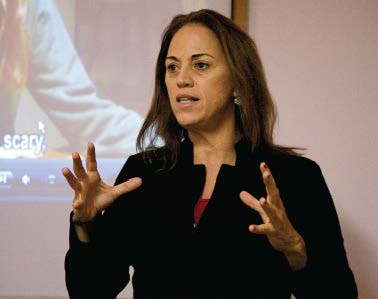
The Powerful Debut of Two New Israeli Legislators
I have listened to myriad political speeches in my life, most eminently forgettable. Few, if any, have left me moved almost to tears. When I read and then watched Ruth Calderon’s debut speech to the Knesset in February I found myself shaking my head in wonder, with my eyes brimming.
I have watched Calderon grow into a stellar leader. She has a Ph.D. in Talmud from the Hebrew University, one of the most rigorous and demanding Talmud departments in the world; it’s the one fictionalized — with a kernel of truth — in the Academy Award- nominated film “Footnote.” She has created two outstanding secular institutions — Elul in Jerusalem and Alma in Tel Aviv — where traditional and non-traditional Jews can learn together, experiencing how the study of rabbinic teachings can be far more than a scholarly enterprise, uplifting and invigorating and instructive for all Jews.
Calderon’s was one of two astonishing speeches given during this round of inaugural Knesset member talks. The other was by new Labor Party M.K . Merav Michaeli; she is a journalist and the granddaughter of Yisrael Kastner, who negotiated with Adolf Eichmann to rescue thousands of Hungarian Jews and was assassinated in Israel in the 1950s. Michaeli presented herself as an unabashed feminist, and she raised consciousness even by alternating feminine and masculine forms in the Hebrew of her debut speech. She declared that a goal of feminism is to build a more just and equitable society for all, especially those who in Israel are underrepresented and oppressed, including people of color and those disabled, among others. She eloquently challenged her listeners to pay attention to — and share their resources with — the have-nots.
Both the Calderon and Michaeli speeches were unprecedented cultural events. I felt as if — hope springs eternal even among those of us who study Shoah and genocide — this might well be a marker in the history of the State of Israel.
The Calderon speech was a moment when secular or, for lack of a better term, non-Orthodox Israelis stood up and took possession of Jewish tradition and heritage in the most public and official of forums. Those who had for far too long looked upon anything that smacked of tradition with contempt and anger — and if I had to live in Israel under the thumb of the Rabbanut, the Orthodox religious authorities, I too would be brimming with contempt and anger — proclaimed: “It is our tradition too. We own it as much as the woman with her head completely covered and the man with the black Borsalino hat perched on the back of his head. Not only are we co-owners, but we rejoice in it as you do.”
Ruth Calderon captured the attention of a state and a people; the video of her speech has gone viral on YouTube. I watched in disbelief and in joy as M.K. Yitzhak Vaknin, a member of the right-wing religious Shas faction, commented aloud as Calderon taught a passage of Talmud during her speech. When someone from Calderon’s own party, Yesh Atid, berated Vaknin for interrupting, Calderon corrected her colleague and proclaimed: “I welcome participation in divrei Torah, study of Torah.” We witnessed something most Shas members and other “black hat” Jews vehemently oppose: men and women studying Torah together — and in the Knesset, no less! But Vaknin was so caught up with what Calderon was teaching that he could not restrain himself. For that brief shining moment two Jews from opposite ends of the religious spectrum were brought together, not by fear of a common enemy but by a shared love of our tradition and its pivotal text.
Not only did he participate in her Talmud teaching but, when she ended her talk with a prayer, he passionately and enthusiastically answered, Amen. For a Haredi Jew to answer amen to a women’s prayer in such a public setting, a place which might be described as the epitome of Israel’s public square, was breathtaking.
Let us hope that Calderon’s speech and Vaknin’s reaction remain far more than just a passing moment. May the day soon come when the most remarkable thing about such a speech is just how unremarkable it is.
V’chen yehi ratzon, and so may it come to be.
And let us all say, Amen.
Deborah Lipstadt is Dorot Professor of Modern Jewish and Holocaust Studies at Emory University. Her most recent book is The Eichmann Trial (Schocken/Nextbook). She is currently writing a book on the history and development of Holocaust Studies.
Rocking the Knesset — Just by Teaching Talmud
Ruth Calderon in her Knesset debut did not explicity discuss the platform of her party, Yesh Atid, but instead did something unprecedented. Finding a metaphor for bringing together secular and religious Israelis — those who serve in the army and those who give their lives to yeshiva study — she, a secular educator, and a woman, explicated a passage of Talmud.
I wish to tell you a story from Talmud, one small story, the story of Rabbi Rechumei, which appears in Ketubot 62b, and through it to say some words about this moment and about the tasks I will set for myself in the Knesset.
… Rabbi Rechumei was constantly before Rava in Mechoza. He would habitually come home every Yom Kippur Eve. One day the topic drew him in. His wife anticipated him: “Here he comes. Here he comes.” He didn’t come. She became upset. She shed a tear from her eye. He was sitting on a roof. The roof collapsed under him, and he died.
Rabbi Rechumei — a rabbi, a rav, a whole lot of man [“rav” can mean “rabbi” or “much”]. “Rechumei” in Aramaic means “love.” Rechumei is derived from the word “rechem,” womb, someone who knows how to include, how to completely accept, just as a woman’s womb contains the baby. This choice of word for “love” is quite beautiful. We know that the Greek word for “womb” gives us the word “hysteria.” The Aramaic choice to take the womb and turn it into love is a feminist gesture by the Sages.
….He could be found, that is, he studied, he was accepted for study, in the great yeshiva, one of the four yeshivot, the Ivy League, of Babylonia: Nehardea, Mechoza, Pumbedita, and Sura. He studied at Mechoza; he studied in the presence of Mechoza’s rosh yeshiva, who was so well known that he was called Rava. In Aramaic, an aleph at the end of a word denoted the definite article. Rava was “the Rav,” “the Rabbi.”
He would habitually — I suggest that the Sages do not like people who do things out of habit; in general, when someone in the Talmud does something regularly, someone dies within a few lines. He would habitually come home — in Aramaic, “home” also means “wife.” It is both wife and home. That is, a man who has no wife is homeless. A woman who has no man is not, but a man without a wife, no home. He would habitually come home every Yom Kippur Eve. Notice that the Gemara says “He would habitually come home every Yom Kippur Eve.” There is a certain rabbinic irony here. What does “every” mean? Once a year. Not very often.
You are probably thinking: what kind of date is that to choose to come home? Yom Kippur Eve? It is not exactly a day of intimacy. It is generally a day of prayer, and not even at home.
One day, one time, one year, the topic drew him in. The study in the beit midrash so fascinated him that he forgot. He did not leave in time. He could not abandon his studies and he did not go home. His wife anticipated him: “Here he comes. Here he comes.” One can hear the aspirant tone of her words in Aramaic: “Hhhashta atei; hhhere he comes.” This expectation, that every text message, every phone call, every footfall, every knock at the door, you are certain is him. Here he comes. Here he comes.
He didn’t come.
At some point, she realizes that he is not coming this year. Perhaps the shofar blast announcing the onset of Yom Kippur was sounded, after which nobody would arrive, due to the sanctity of the holiday. She becomes upset. This woman, who waited all year, who for many years has waited all year for one day, cannot stand it anymore. She becomes upset. She is disappointed; she is sorrowful; she loses control. She sheds a tear from her eye — this is an active verb, not a passive one. She allows one tear to leak out of her eye onto her cheek, after years of not crying.
Now we must imagine a split screen: on one side is a close-up of a female character, a woman with one tear running down her cheek. On the other side, sitting on a rooftop in Mechoza, is Rabbi Rechumei, dressed entirely in white and feeling holy. You know, after several hours without food we feel very exalted. He studies Torah on the roof, under the stars, and feels so close to the heavens. He sat on the roof, and as the tear falls from the woman’s eye, the roof caves in under him and he falls to the ground and dies.
What can I learn about this place and my work here from Rabbi Rechumei and his wife? First, I learn that one who forgets that he is sitting on another’s shoulders will fall. …
I learn that often, in a dispute, both sides are right, and until I understand that both my disputant and I, both the woman and Rabbi Rechumei, feel that they are doing the right thing and are responsible for the home. Sometimes we feel like the woman, waiting, serving in the army, doing all the work while others sit on the roof and study Torah; sometimes those others feel that they bear the entire weight of tradition, Torah, and our culture while we go to the beach and have a blast. Both I and my disputant feel solely responsible for the home. Until I understand this, I will not perceive the problem properly and will not be able to find a solution. I invite all of us to years of action rooted in thought, and dispute rooted in mutual respect and understanding.
I aspire to bring about a situation in which Torah study is the heritage of all Israel, in which the Torah is accessible to all who wish to study it, in which all young citizens of Israel take part in Torah study as well as military and civil service. Together we will build this home…
Translated for the Jewish Week (jewishweek.com) by Elli Fischer. Used with permission.
Watch videos of the full Knesset addresses by Calderon and Michaeli in Hebrew with English subtitles on YouTube.



